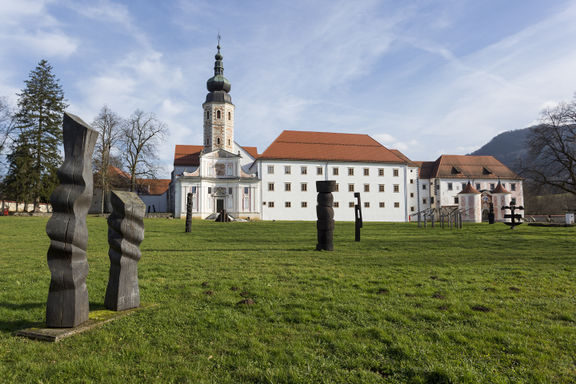Difference between revisions of "Kostanjevica Monastery"
(→External links: added link) |
Janez Premk (talk | contribs) |
||
| Line 49: | Line 49: | ||
A lapidary collection of medieval masonry fragments such as a keystone with stylised palmettes, a robust cup-shaped capital, a figural capital, a little fragment with a preserved mason's mark and a remnant of a Gothic painting on part of a vault's rib is on display. | A lapidary collection of medieval masonry fragments such as a keystone with stylised palmettes, a robust cup-shaped capital, a figural capital, a little fragment with a preserved mason's mark and a remnant of a Gothic painting on part of a vault's rib is on display. | ||
| − | The [[Božidar Jakac Gallery, Kostanjevica na Krki|Božidar Jakac Gallery]] was opened here in 1974 focused initially on the artistic legacy of local painter Jože Gorjup, works donated by Tone Kralj and graphic art by Božidar Jakac. | + | The [[Božidar Jakac Gallery, Kostanjevica na Krki|Božidar Jakac Gallery]] was opened here in 1974, focused initially on the artistic legacy of local painter [[Jože Gorjup]], works donated by [[Tone Kralj]], and graphic art by [[Božidar Jakac]]. |
| − | Permanent collections represent Slovene artists of the 20th century, including France Kralj, France Gorše, Zoran Didek, Janez Boljka and Bogdan Borčić. In the upper part of the monastery's southern wing is an important collection of 44 oil paintings by French, Flemish, Italian and German old masters opened in Kostanjevica in 1977 which were previously owned by the nearby [[Pleterje Charterhouse Monastery]]. | + | Permanent collections represent Slovene artists of the 20th century, including [[France Kralj]], [[France Gorše]], [[Zoran Didek]], [[Janez Boljka]], [[and Bogdan Borčić]]. In the upper part of the monastery's southern wing is an important collection of 44 oil paintings by French, Flemish, Italian and German old masters opened in Kostanjevica in 1977 which were previously owned by the nearby [[Pleterje Charterhouse Monastery]]. |
Temporary exhibits presenting works by current Slovene and foreign artists are displayed in the monastery church (eg Nataša Prosenc, Silvan Omerzu, Uršula Berlot, Jože Slak, Roman Makše, Anda Klančič). Temporary exhibits are presented also in some adjoining rooms. | Temporary exhibits presenting works by current Slovene and foreign artists are displayed in the monastery church (eg Nataša Prosenc, Silvan Omerzu, Uršula Berlot, Jože Slak, Roman Makše, Anda Klančič). Temporary exhibits are presented also in some adjoining rooms. | ||
Revision as of 19:08, 28 March 2010
History
Initially the monastery was built as a three-nave church with a transversal nave and a flat-ended choir area (Bernadine ground plan). During the 15th century a bell tower was added to the church and the naves were shortened on the west side, supposedly due to the difficulties connected with the bearing capacity of the terrain.
During the 17th and 18th centuries the entrance was remodelled, the choir loft was extended and the naves were re-vaulted. Construction of the monastery buildings began in the late 14th century; a hall was added in the 16th century and residential wings with arcades in the 18th century.
After the abolition of the monasteries in 1786 by the Emperor Joseph II the altars and other church fittings were taken away or sold. Thereafter the monastery buildings fell into decay, and were finally burnt down in 1942. The renovation commenced in 1958 and by 1971 the church had been reconstructed by the Institute for the Protection of Cultural Heritage of Slovenia.
Premises
The Baroque monastery with some older Cistercian elements and the early Gothic church no longer operates as a monastery but is devoted purely to secular activities. The oldest part of the monastery complex is the Church of St Mary along with the remaining foundations of the former ground floor of the cloister. The ground floor plan accommodates the general plan of Bernard that is a three nave church with a crossing nave and two pairs of chapels alongside the square choir. The church distinguished the arch system and a very rich early Gothic capital work of piers and engaged pillars.
The arcade courtyard is not only one of the biggest in Slovenia, but also in Central Europe. Rich church fittings had been after 1820 completely sold, and murals from the first third of the 16th century were destroyed.
The mural of Maria's Assumption on the western façade and The Saving of the Monastery from the Uskok Invasion in 1736, painted on the small wall between the defending towers, are the art work by the painter Franc Jelovšek (1700–1764) painted between 1740 and 1742.
Exhibitions
A lapidary collection of medieval masonry fragments such as a keystone with stylised palmettes, a robust cup-shaped capital, a figural capital, a little fragment with a preserved mason's mark and a remnant of a Gothic painting on part of a vault's rib is on display.
The Božidar Jakac Gallery was opened here in 1974, focused initially on the artistic legacy of local painter Jože Gorjup, works donated by Tone Kralj, and graphic art by Božidar Jakac.
Permanent collections represent Slovene artists of the 20th century, including France Kralj, France Gorše, Zoran Didek, Janez Boljka, And Bogdan Borčić. In the upper part of the monastery's southern wing is an important collection of 44 oil paintings by French, Flemish, Italian and German old masters opened in Kostanjevica in 1977 which were previously owned by the nearby Pleterje Charterhouse Monastery.
Temporary exhibits presenting works by current Slovene and foreign artists are displayed in the monastery church (eg Nataša Prosenc, Silvan Omerzu, Uršula Berlot, Jože Slak, Roman Makše, Anda Klančič). Temporary exhibits are presented also in some adjoining rooms.
A selection of wooden sculptures by artists of several nationalities has been displayed in the grounds of the monastery since the Forma Viva exhibition of 1961.
See also
- Božidar Jakac Gallery
- Forma Viva Open Air Wood Sculpture Collection, Kostanjevica na Krki
- Pleterje Charterhouse Monastery
- Stična Cistercian Abbey
- Olimje Monastery



